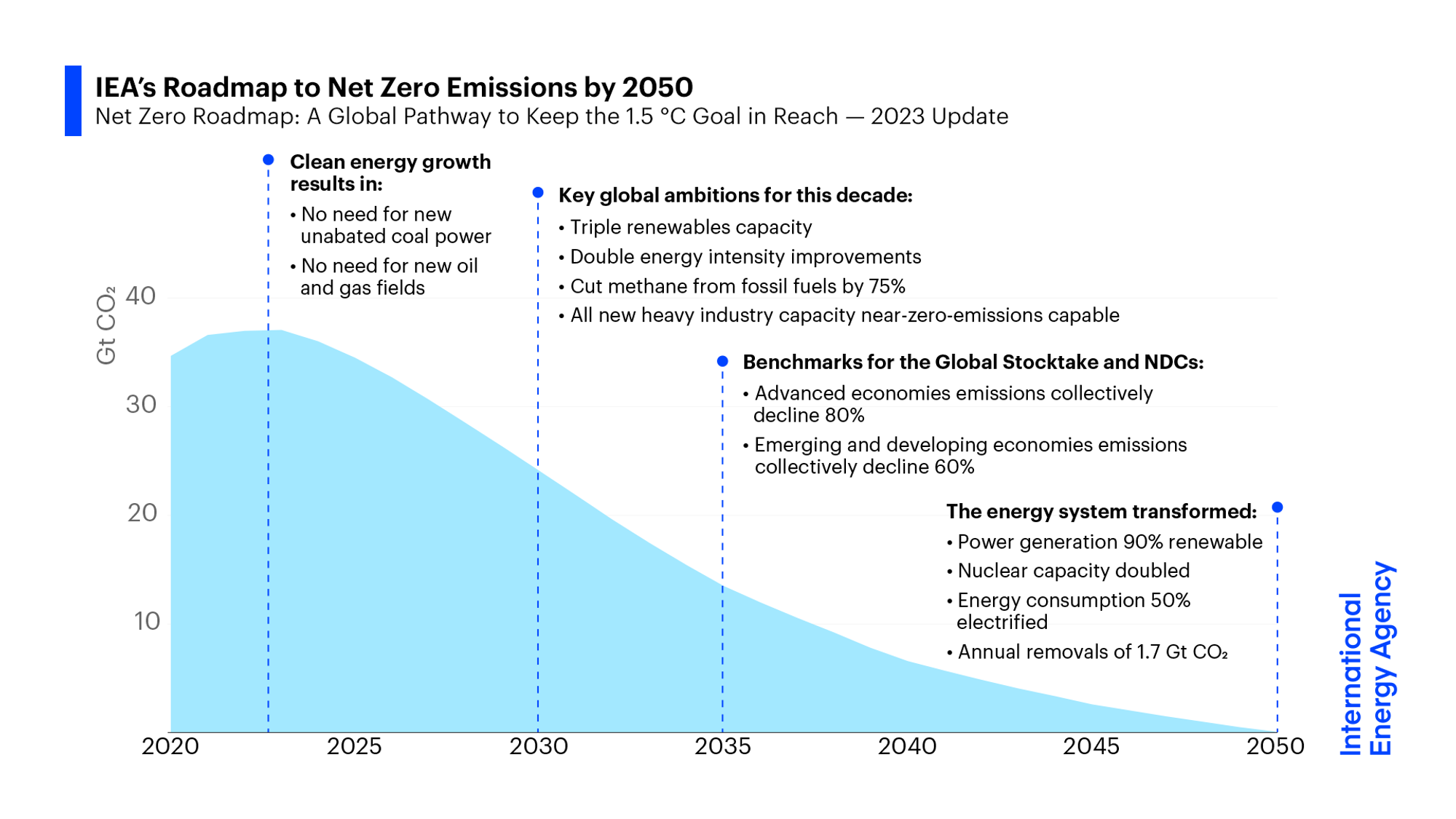IEA – Newsletter of the International Energy Agency Click here to view in your browser The path to limiting global warming to 1.5 °C has narrowed, but clean energy growth is keeping it open
We just released a new edition of our landmark Net Zero Roadmap, which shows that driving down greenhouse gas emissions from the world’s energy sector to net zero and limiting global warming to 1.5 ̊C remains possible due to the record growth of key clean energy technologies – though momentum still needs to increase rapidly in many areas.
The 2023 edition of the Roadmap sets out a global pathway to keep the 1.5 ̊C goal in reach, providing a comprehensive update to the groundbreaking original report, which was published in 2021 and has served as an essential benchmark for policy makers, industry, the financial sector and civil society. The 2023 update incorporates the significant changes to the energy landscape in the past two years, including the post-pandemic economic rebound and the extraordinary growth in some clean energy technologies – but also increased investment in fossil fuels and stubbornly high emissions.
Some key takeaways:
- Record growth in solar power capacity and electric car sales are in line with a pathway towards net zero emissions globally by mid-century, as are industry plans for the roll-out of new manufacturing capacity for them. This is significant, since those two technologies alone deliver one-third of the emissions reductions between today and 2030 in the pathway.
- Clean energy innovation has also been delivering more options and lowering technology costs. In the IEA’s original Roadmap in 2021, technologies not yet available on the market delivered nearly half of the emissions reductions needed for net zero in 2050. That number has now fallen to around 35% in this year’s update.
- Yet bolder action is necessary this decade. In this year’s updated net zero pathway, global renewable power capacity triples by 2030. Meanwhile, the annual rate of energy efficiency improvements doubles, sales of electric vehicles and heat pumps rise sharply, and energy sector methane emissions fall by 75%.
- This huge policy-driven ramping up of clean energy capacity drives fossil fuel demand 25% lower by 2030. By 2050, fossil fuel demand falls by 80%. As a result, no new unabated coal plants are needed. Neither are new long-lead-time upstream oil and gas projects, new coal mines or mine extensions. Nonetheless, continued investment is required in some existing oil and gas assets and already approved projects to avoid damaging price spikes.
- Stronger international cooperation is needed. The report warns that a failure to sufficiently step up ambition and implementation between now and 2030 would create additional climate risks and make achieving the 1.5 ̊C goal dependant on the massive deployment of carbon removal technologies, which are expensive and unproven at scale.
- In a Delayed Action Case the report examines, a failure to expand clean energy quickly enough by 2030 means nearly 5 billion tonnes of carbon dioxide would have to be removed from the atmosphere every year during the second half of this century. If carbon removal technologies fail to reach this target, returning the temperature to 1.5 ̊C would not be possible.
- It is also essential to foster an equitable global transition that takes different national circumstances into account, the report finds. For example, advanced economies reach net zero sooner to allow emerging and developing economies more time.
- Nonetheless, staying on track means almost all countries must move forward their targeted net zero dates. It also hinges on mobilising a significant increase in investment, especially in emerging and developing economies. In the new zero pathway, global clean energy spending rises from USD 1.8 trillion in 2023 to USD 4.5 trillion annually by the early 2030s.
For more details, check out the press release, the report’s executive summary and a thread on X (formerly Twitter) from our Executive Director Fatih Birol outlining the key findings. The full report can be found here.
And don’t miss a webinar with journalists on the updated roadmap led by Dr Birol and the two lead authors of the report, Laura Cozzi, our Agency’s Director of Sustainability, Technology and Outlooks, and Timur Gül, the IEA’s Chief Energy Technology Officer. It will be livestreamed today at 11 a.m. CEST.
ENERGY SNAPSHOT

Our Net Zero Roadmap sets out a pathway to the common goal of net zero emissions by 2050, but it is not the only one. Different countries will need to chart their own routes depending on their own circumstances and capacities. Nonetheless, even with these regional differences, there are some key milestones that are important for policy makers around the world to take into account, as reflected in the image above. Read more in the full report online.
See you soon!
There will be more on the 2023 update of our Net Zero Roadmap as well as our other recent reports and activities in our regularly scheduled edition of The Energy Mix this coming Monday – including details on the IEA Critical Minerals and Clean Energy Summit and IEA-ECB-EIB Conference on Ensuring an Orderly Energy Transition that will take place at our headquarters in Paris later this week.
SourceIEA
EMR Analysis
More information on IEA (International Energy Agency): https://www.iea.org + The IEA is at the heart of global dialogue on energy, providing authoritative analysis, data, policy recommendations, and real-world solutions to help countries provide secure and sustainable energy for all.
The IEA was created in 1974 to help co-ordinate a collective response to major disruptions in the supply of oil. While oil security this remains a key aspect of our work, the IEA has evolved and expanded significantly since its foundation.
Taking an all-fuels, all-technology approach, the IEA recommends policies that enhance the reliability, affordability and sustainability of energy. It examines the full spectrum issues including renewables, oil, gas and coal supply and demand, energy efficiency, clean energy technologies, electricity systems and markets, access to energy, demand-side management, and much more.
Since 2015, the IEA has opened its doors to major emerging countries to expand its global impact, and deepen cooperation in energy security, data and statistics, energy policy analysis, energy efficiency, and the growing use of clean energy technologies.
More information on Net Zero: https://www.iea.org/reports/net-zero-by-2050 + The number of countries announcing pledges to achieve net zero emissions over the coming decades continues to grow. But the pledges by governments to date – even if fully achieved – fall well short of what is required to bring global energy-related carbon dioxide emissions to net zero by 2050 and give the world an even chance of limiting the global temperature rise to 1.5 °C. This special report is the world’s first comprehensive study of how to transition to a net zero energy system by 2050 while ensuring stable and affordable energy supplies, providing universal energy access, and enabling robust economic growth. It sets out a cost-effective and economically productive pathway, resulting in a clean, dynamic and resilient energy economy dominated by renewables like solar and wind instead of fossil fuels. The report also examines key uncertainties, such as the roles of bioenergy, carbon capture and behavioral changes in reaching net zero.
More information on Dr. Fatih Birol (Executive Director, International Energy Agency): https://www.iea.org/contributors/dr-fatih-birol + https://www.linkedin.com/in/fatih-birol/
More information on Laura Cozzi (Director of Sustainability, Technology and Outlooks, International Energy Agency): https://www.iea.org/contributors/laura-cozzi + https://www.linkedin.com/in/laura-cozzi-b427061/
More information on Timur Gül (Chief Energy Technology Officer, International Energy Agency): https://www.iea.org/contributors/timur-gul + https://www.linkedin.com/in/timur-g%C3%BCl-5a34953b/
EMR Additional Notes:
- Global Warming: Global warming is the long-term heating of Earth’s climate system observed since the pre-industrial period (between 1850 and 1900) due to human activities, primarily fossil fuel burning, which increases heat-trapping greenhouse gas levels in Earth’s atmosphere.
- Global Warming potential (GWP):
- The heat absorbed by any greenhouse gas in the atmosphere, as a multiple of the heat that would be absorbed by the same mass of carbon dioxide(CO2). GWP is 1 for CO2. For other gases it depends on the gas and the time frame.
- Carbon dioxide equivalent (CO2e or CO2eq or CO2-e) is calculated from GWP. For any gas, it is the mass of CO2 which would warm the earth as much as the mass of that gas. Thus it provides a common scale for measuring the climate effects of different gases. It is calculated as GWP times mass of the other gas. For example, if a gas has GWP of 100, two tonnes of the gas have CO2e of 200 tonnes.
- GWP was developed to allow comparisons of the global warming impacts of different gases.
- Greenhouse Gas (GHG):
- A greenhouse gas is any gaseous compound in the atmosphere that is capable of absorbing infrared radiation, thereby trapping and holding heat in the atmosphere. By increasing the heat in the atmosphere, greenhouse gases are responsible for the greenhouse effect, which ultimately leads to global warming.
- The main gases responsible for the greenhouse effect include carbon dioxide, methane, nitrous oxide, and water vapor (which all occur naturally), and fluorinated gases (which are synthetic).

- Hydrofluorocarbons (HFC):
- Hydrofluorocarbons (HFCs) are a group of industrial chemicals primarily used for cooling and refrigeration. HFCs were developed to replace stratospheric ozone-depleting substances that are currently being phased out under the Montreal Protocol on Substances that Deplete the Ozone Layer.
- Many HFCs are very powerful greenhouse gases and a substantial number are short-lived climate pollutants with a lifetime of between 15 and 29 years in the atmosphere.
- Carbon Dioxide (CO2):
- Primary greenhouse gas emitted through human activities. Carbon dioxide enters the atmosphere through burning fossil fuels (coal, natural gas, and oil), solid waste, trees and other biological materials, and also as a result of certain chemical reactions (e.g., manufacture of cement). Carbon dioxide is removed from the atmosphere (or “sequestered”) when it is absorbed by plants as part of the biological carbon cycle.
- Decarbonization:
- Reduction of carbon dioxide emissions through the use of low carbon power sources, achieving a lower output of greenhouse gasses into the atmosphere.


